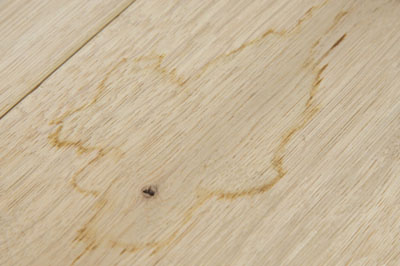Fixing Problems
Fix, repair, renovate and replenish.
Like any natural material, wood requires care and attention to keep it looking its best.

Repairing Scratches
Even on a perfectly clean floor, life will eventually leave traces. This is not a problem because Osmo Polyx®-Oils can be applied layer upon layer over the years, which is a huge advantage over varnishes; which need to be sanded and re-applied during renovation and repairs.
Small scratches: apply a small amount of oil (5ml sachets are perfect for this) onto the damaged area, and rub with a scotch pad or cloth. Leave for a minute or so, and wipe any excess off with a dry cloth.
Deep scratches: simply cordon off the damaged board/plank(s) of wood, and sand to remove the bulk of the scratch using possibly an 80g, depending on the extent of the scratch. Finish with 120g and re-apply Polyx®-Oil. It is important to apply two coats when sanding back to the bare wood surface.

Removing Water Marks
Osmo Polyx®-Oil and TopOil are microporous hardwax-oils with extremely high water resistance. The finish is proven against wine, beer, cola, coffee, tea, fruit juices, milk and water.
These types of liquid spillages will tightly bead on the surface without leaving any permanent marks, simply clean by wiping with a dry cloth. However, if these types of liquids are allowed to sit on the surface for prolonged lengths of time (more than approx. 15 hours) without cleaning, then marking can appear. Remove by partial sanding and re-applying the finish.

Peeling, Blistering, Flaking and Cracking
Wood is a natural material that expands and contracts as it releases and absorbs moisture.
All Osmo products are natural oil based which allow the wood to breathe. As the oil penetrates into the surface of the timber, it doesn’t form a surface coating and so will not crack, peel, flake or blister. Moisture can escape but cannot be absorbed.
Osmo finishes penetrate deep into the grain aiding the natural elasticity of the wood and helping to reduce shrinkage and swelling. Varnishes and lacquers form a film on the surface which will eventually flake and crack on the surface. Sanding is essential to rectify such issues, you will find that this is not an issue that occurs with wood protected with Osmo.

Blackening of Exterior Wood
Oak has a high natural tannic acid content which causes the timber to turn black when exposed to moisture containing trace amounts of iron. As a result external oak requires more frequent care and maintenance than most other species, particularly in its first couple of years of exposure to the elements, to maintain its decorative appearance.
When water penetrates oak it reacts with the tannins within the oak, resulting in ‘blackening’.
The levels of rain, wind and sun will make a difference as to how quickly the oak changes its appearance. Regular washing with a fungicidal wash, will help to remove surface contaminants. At the same time we recommend all external joints, gaps and end grain to be inspected and any defects repaired.


